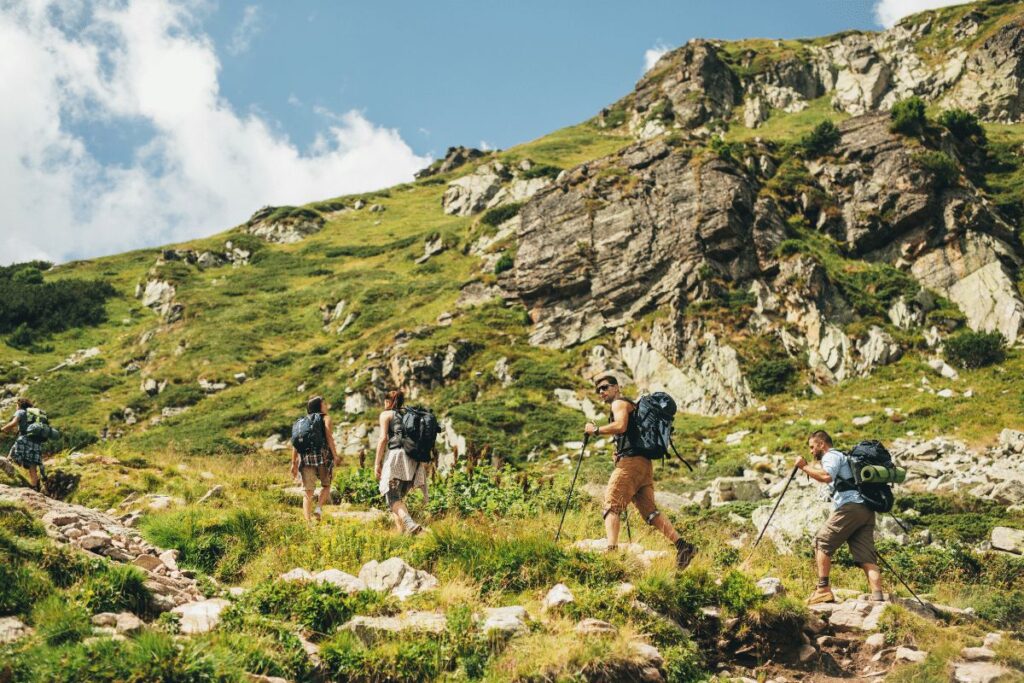Hike 20 Seattle peaks with us! Experience breathtaking views and possible wildlife encounters on each summit adventure.
Strap on your hiking boots and join us on a journey to the top of 20 peaks around Seattle! We’ve conquered every summit, from the steep slopes of Mt. Rainier to the rugged face of Granite Mountain.
Along the way, we’ve even bumped into some of the local wildlife – think of it as nature’s bonus round. Ready to find out which peaks offer the best views and the chance encounters with the critters that call them home?
Let’s hit the trails and see what adventures await above the Emerald City!
Mt Deception
Mount Deception is a prominent peak located in the Olympic Mountains, approximately 70 miles west of Seattle. It is the fourth-highest peak in the Olympics, standing at an elevation of 7,788 feet.
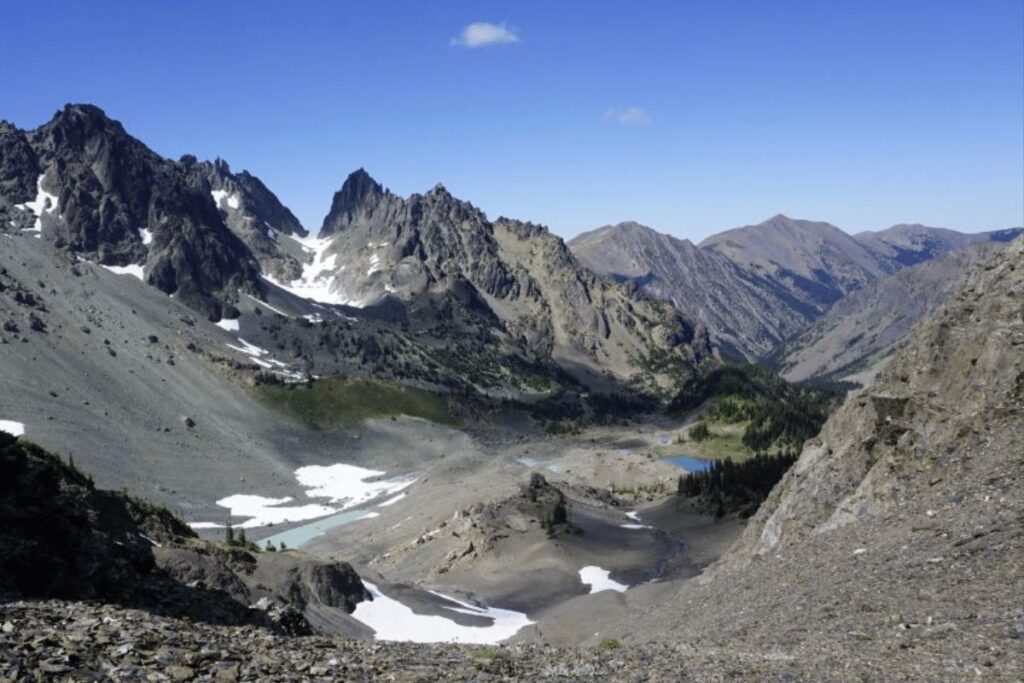
The hike to Mount Deception is considered one of the most challenging hikes in the region, and it is recommended for experienced hikers only. The trailhead starts at the Dungeness River Bridge and follows the Royal Basin Trail for approximately 8 miles, gaining over 5,000 feet in elevation before reaching the summit. The trail can be quite steep and strenuous in some sections, and hikers should be prepared for difficult terrain.
However, the rewards of this challenging hike are well worth the effort. The summit of Mount Deception offers breathtaking views of the surrounding mountains and glaciers, as well as panoramic views of the Olympic Peninsula and the Strait of Juan de Fuca. On a clear day, hikers can even see Mount Rainier and the Seattle skyline in the distance.
Hikers should be aware that the Mount Deception hike requires a permit from Olympic National Park, and it is recommended to obtain the permit in advance due to limited availability. Additionally, hikers should be prepared for changing weather conditions and should bring plenty of water, food, and warm clothing.
Overall, Mount Deception is a challenging but rewarding hike that offers stunning views of the Olympic Mountains and the surrounding region. It is an excellent choice for experienced hikers looking for a challenging adventure.
Mt Stone
Mt Stone is a beautiful peak located in the Olympic Mountains, about 2 hours west of Seattle. It stands at an elevation of 6,940 feet and is the fifth-highest peak in the Olympics.
The hike to Mt Stone is a challenging but rewarding adventure that takes hikers through lush forests, alpine meadows, and rocky ridges. The trailhead starts at the Lena Lake trailhead and follows the Lena Lake trail for approximately 3 miles before turning onto the unmaintained trail towards Mt Stone.
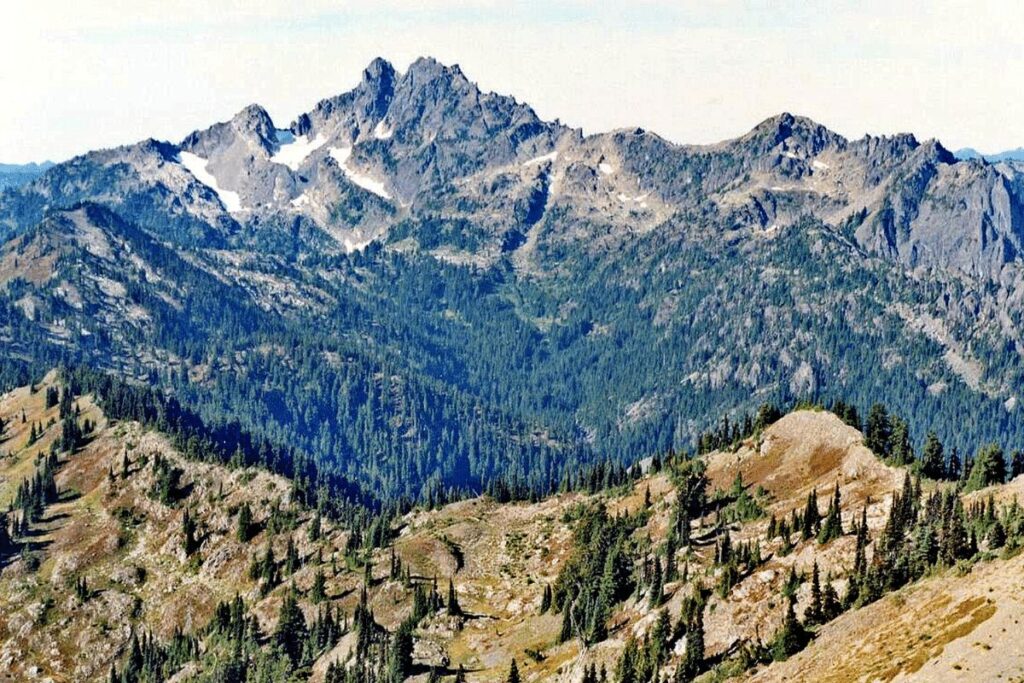
The trail is quite steep and rocky, with some scrambling required in some sections, so hikers should be experienced and prepared for difficult terrain.
The summit of Mt Stone offers breathtaking panoramic views of the Olympic Mountains, Hood Canal, and the surrounding forests. On a clear day, hikers can even see Mount Rainier and the Seattle skyline in the distance.
It is important for hikers planning to summit Mt Stone to note that a permit from Olympic National Park is required for this hike, and it is recommended to obtain the permit well in advance due to the limited availability.
Moreover, hikers should be well-prepared for unpredictable weather conditions and should carry ample food, water, and warm clothing to stay safe during the hike.
Despite the challenging nature of the hike, the stunning views from the summit of Mt Stone make it a truly rewarding experience.
Boulder Peak
Boulder Peak is a prominent peak located in the North Cascades, just over 2 hours northeast of Seattle. Standing at an elevation of 8,320 feet, it offers breathtaking panoramic views of the surrounding peaks and valleys.
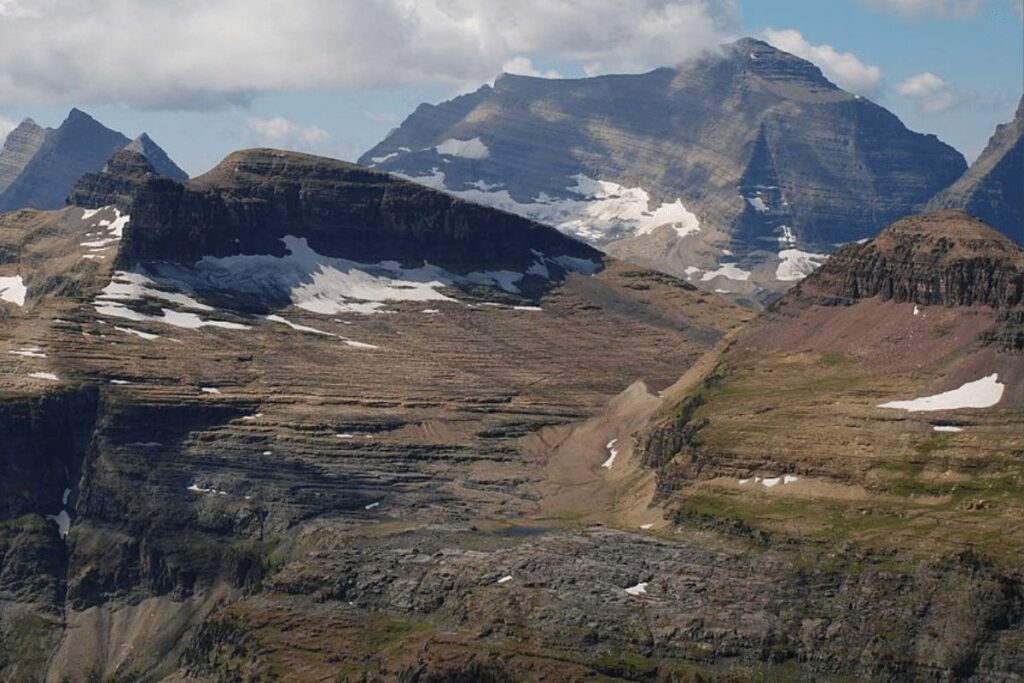
The hike to Boulder Peak is considered a challenging adventure, with steep and rocky terrain. The trailhead starts at the Thunder Creek Trail and follows the trail for approximately 4 miles before turning onto the Boulder Creek Trail. The trail is well-marked, but hikers should be prepared for steep ascents and descents, rocky sections, and potentially hazardous conditions due to changing weather.
Despite the challenging nature of the hike, the stunning views from the summit of Boulder Peak make it a truly rewarding experience. From the top, hikers can see a vast expanse of mountain ranges, glaciers, and valleys. The trail also takes hikers through beautiful forests, meadows, and streams, adding to the overall appeal of this hike.
Hikers should be well-prepared for the climb with proper gear, food, and water. Additionally, a permit is required for the hike, which can be obtained in advance from the North Cascades National Park Service.
Boulder Peak is a challenging but breathtaking hike that offers stunning views of the North Cascades and the surrounding region. It is an excellent choice for experienced hikers looking for a thrilling adventure and a chance to explore the natural beauty of the Pacific Northwest.
McDonald Mountain
McDonald Mountain is a popular hiking destination located in the Olympic Mountains, approximately 2 hours west of Seattle. It stands at an elevation of 4,056 feet and offers spectacular views of the Olympic Mountains, Hood Canal, and the surrounding region.
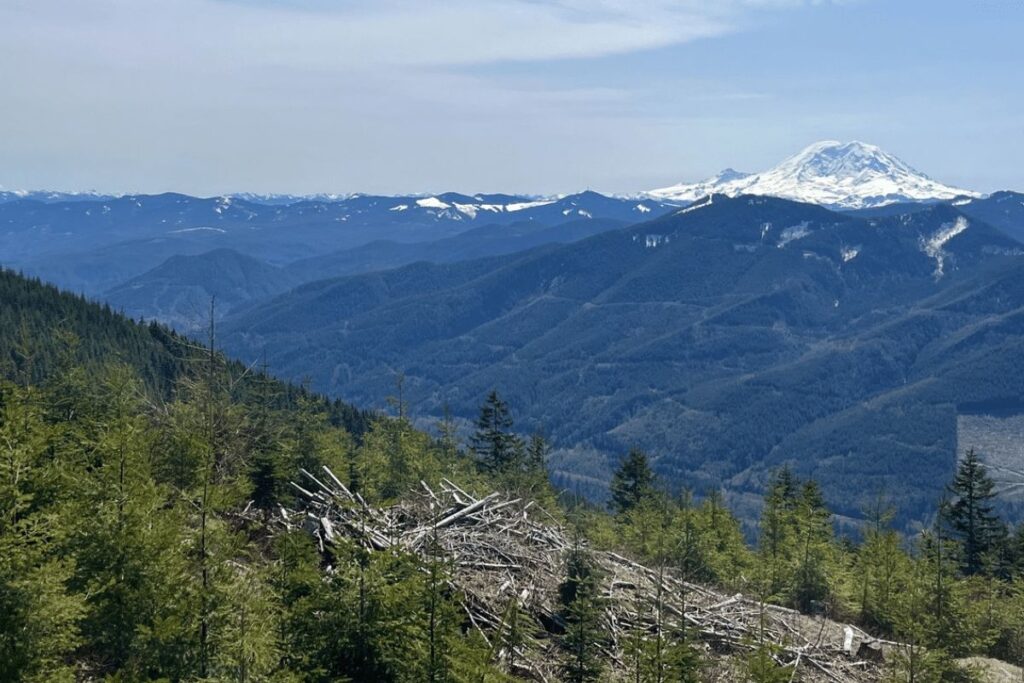
The hike to McDonald Mountain is considered a moderate level hike and takes hikers through lush forests and along ridgelines. The trailhead starts at the Dosewallips River Trail and follows the trail for approximately 5 miles before branching off to the McDonald Mountain Trail. The trail is well-maintained, but hikers should be prepared for a steady uphill climb and some rocky sections.
One unique feature of the McDonald Mountain hike is the historic fire lookout tower located at the summit. The tower was originally built in the 1930s and has been restored to its former glory, offering hikers a chance to experience a piece of Washington State history while taking in the stunning views from the top.
Hikers should be well-prepared with proper gear, food, and water for the climb. Additionally, a Northwest Forest Pass is required to park at the trailhead.
McDonald Mountain is a moderate hike that offers a unique historical experience along with stunning views of the Olympic Mountains. It is an excellent choice for hikers looking for a fun adventure that is both challenging and rewarding.
Bessemer Mountain
Bessemer Mountain is a popular hiking destination located in the North Bend area, approximately 45 minutes east of Seattle. It stands at an elevation of 5,248 feet and offers spectacular views of the Cascade Range, Mount Rainier, and the surrounding region.
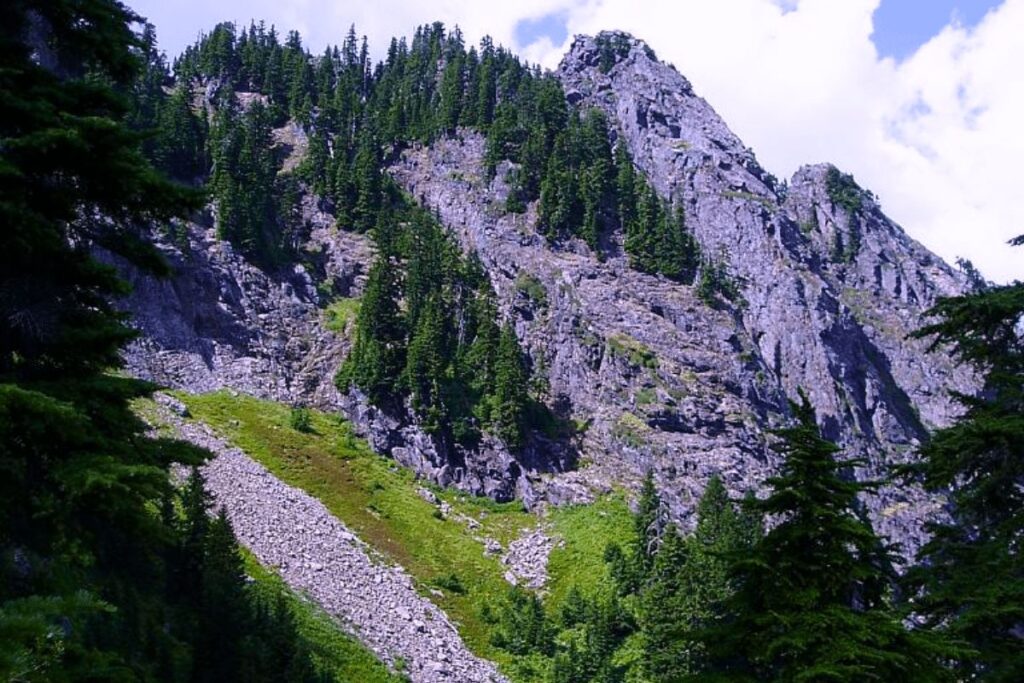
The hike to Bessemer Mountain is considered a challenging adventure, with steep and rocky terrain. The trailhead starts at Bessemer Road and follows the trail for approximately 4 miles before reaching the summit.
Hikers should be prepared for a steady uphill climb, rocky sections, and potentially hazardous conditions due to changing weather.
One unique feature of the Bessemer Mountain hike is the scenic views of Mount Rainier and the surrounding peaks from the summit. Additionally, hikers can explore the historic Bessemer Mine site along the trail, which was active in the early 1900s and played a significant role in the region’s mining history.
Wildlife sightings along the trail are common, with bears, deer, and various bird species often spotted in the area. Hikers should be respectful of the wildlife and follow Leave No Trace principles to ensure the preservation of the natural environment.
Hikers should be well-prepared for the climb with proper gear, food, and water. Additionally, a Northwest Forest Pass is required to park at the trailhead.
Alta Mountain
Alta Mountain is a popular hiking destination located in the Snoqualmie Pass area, approximately 1.5 hours east of Seattle. It stands at an elevation of 6,250 feet and offers stunning views of the Cascade Range, Mount Rainier, and the surrounding wilderness.
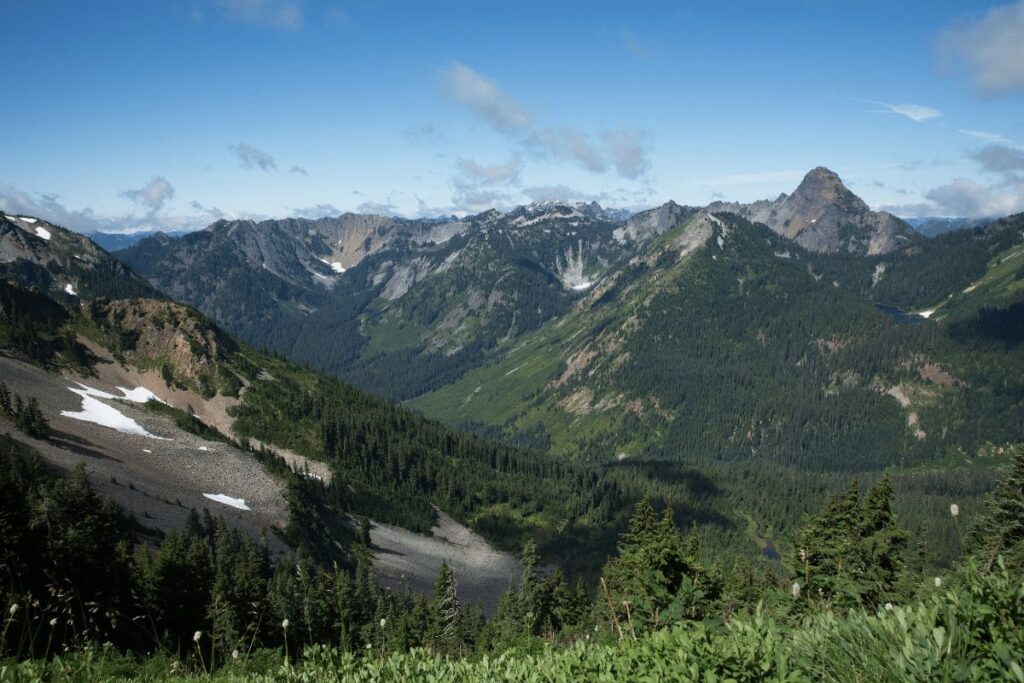
The hike to Alta Mountain is considered a challenging adventure, with steep and rocky terrain. The trailhead starts at the Alpental Ski Area and follows the trail for approximately 5.5 miles before reaching the summit. Hikers should be prepared for a steady uphill climb, rocky sections, and potentially hazardous conditions due to changing weather.
One unique feature of the Alta Mountain hike is the diverse wilderness area surrounding the trail. The hike takes hikers through alpine meadows, subalpine forests, and rocky ridgelines, providing a diverse and breathtaking experience.
Additionally, hikers can explore unique geological features such as the granite spires along the trail, adding to the hike’s beauty and uniqueness.
Wildlife sightings along the trail are common, with various bird species and mountain goats often spotted in the area. Hikers should be respectful of the wildlife and follow Leave No Trace principles to ensure the preservation of the natural environment.
Alta Mountain is a challenging but rewarding hike that offers stunning views of the Cascade Range, Mount Rainier, and the surrounding wilderness, as well as a chance to explore unique geological features and spot wildlife along the trail.
It is an excellent choice for experienced hikers looking for a thrilling adventure and a chance to connect with the natural beauty of the Pacific Northwest.
Cashmere Mountain
Cashmere Mountain is a prominent peak located in the Wenatchee Mountains, approximately 2.5 hours east of Seattle. It stands at an elevation of 8,501 feet and offers breathtaking views of the surrounding peaks, including Mount Stuart, the Enchantments, and the Alpine Lakes Wilderness.
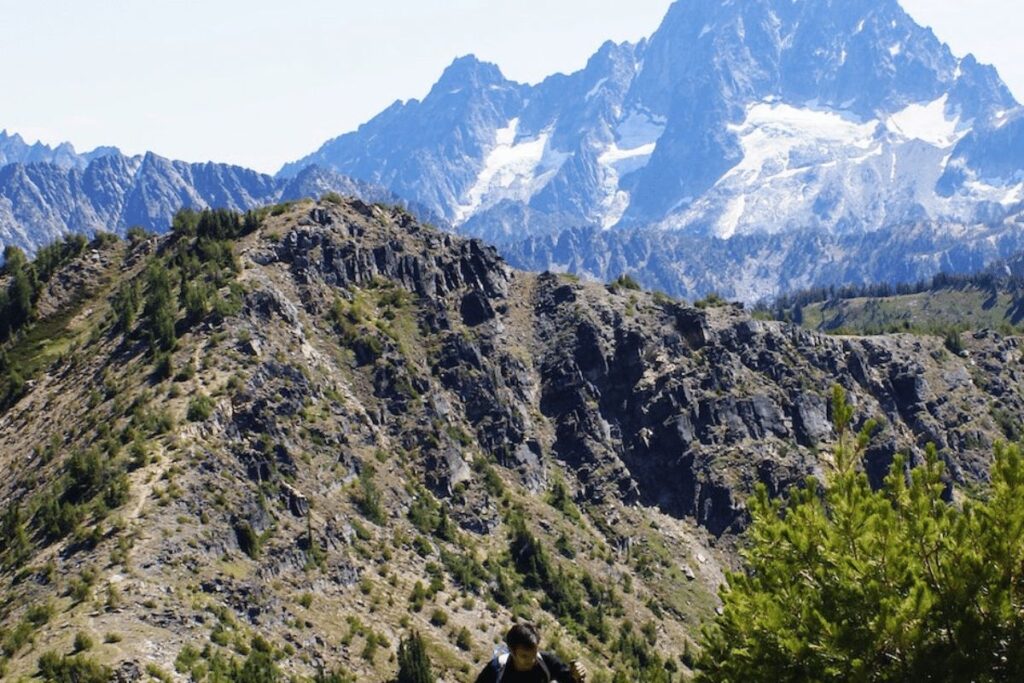
The hike to Cashmere Mountain is considered a challenging adventure, with steep and exposed terrain. The trailhead starts at the end of Forest Road 7601 and follows the trail for approximately 9 miles before reaching the summit.
Hikers should be prepared for a long and strenuous climb, with rocky and uneven terrain, and potentially hazardous conditions due to changing weather.
One unique feature of the Cashmere Mountain hike is the panoramic views from the summit, providing a 360-degree perspective of the surrounding peaks and wilderness areas. The peak’s exposed location also offers a thrilling and adventurous experience for hikers looking for a challenging climb.
The trail to Cashmere Mountain takes hikers through a diverse range of landscapes, including alpine meadows, dense forests, and rocky ridgelines. Along the way, hikers can enjoy the picturesque views of Alpine Lakes Wilderness, which boasts over 700 lakes and stunning mountain scenery.
Wildlife sightings along the trail are common, with black bears, mule deer, and mountain goats often spotted in the area. Hikers should be respectful of the wildlife and follow Leave No Trace principles to ensure the preservation of the natural environment.
Cashmere Mountain is a challenging but rewarding hike that offers breathtaking views of the Wenatchee Mountains and the Alpine Lakes Wilderness, as well as a chance to explore a diverse range of landscapes and spot wildlife along the trail. It is an excellent choice for experienced hikers looking for a thrilling adventure and a chance to connect with the natural beauty of the Pacific Northwest.
Baring Mountain
Baring Mountain is a unique peak located in the Central Cascades, approximately 1.5 hours east of Seattle. It stands at an elevation of 6,125 feet and offers stunning views of the Skykomish River Valley and the surrounding peaks.
The hike to Baring Mountain is considered a challenging adventure, with steep and rocky terrain. The trailhead starts at the Barclay Lake Trailhead and follows the trail for approximately 5.5 miles before reaching the summit. Hikers should be prepared for a steep uphill climb, rocky sections, and potentially hazardous conditions due to changing weather.
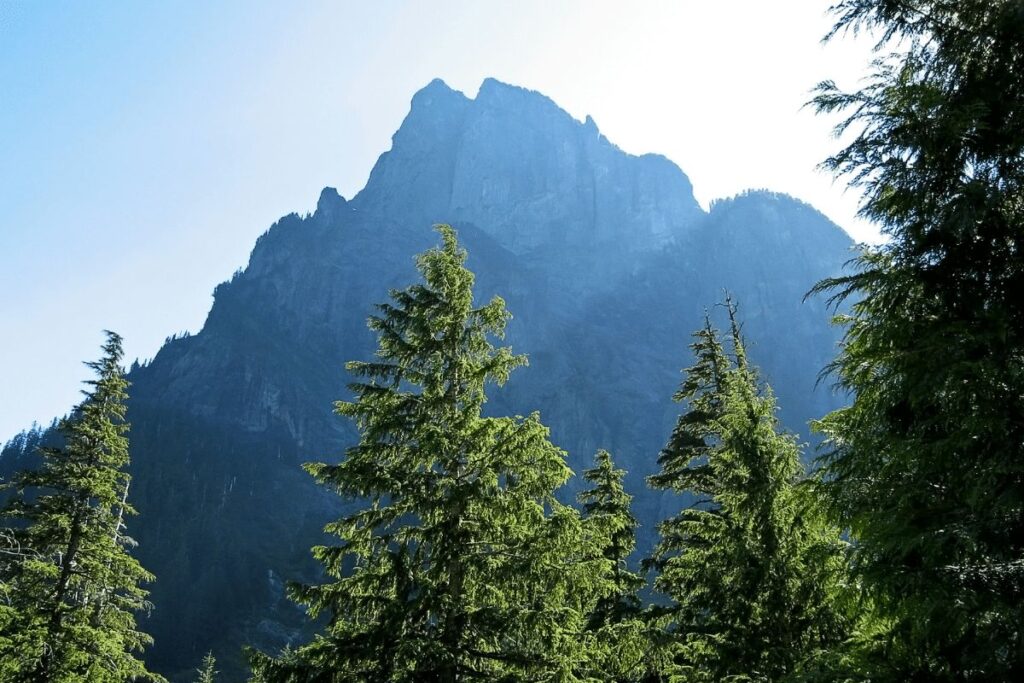
One unique feature of the Baring Mountain hike is the striking rock formations on the summit ridge, known as the “Knife’s Edge.” This narrow and exposed ridge offers a thrilling and adventurous experience for hikers looking for a challenging climb. Additionally, the Knife’s Edge provides stunning panoramic views of the surrounding peaks and valleys.
The trail to Baring Mountain takes hikers through dense forests, over rushing streams, and through alpine meadows, providing a diverse and picturesque experience.
The surrounding wilderness area is also home to a variety of wildlife, including black bears, mountain goats, and cougars, adding to the hike’s unique nature.
Hikers should be well-prepared for the climb with the proper gear, food, and water. Additionally, a Northwest Forest Pass is required to park at the trailhead.
Baring Mountain is a challenging but rewarding hike that offers a unique and adventurous experience with stunning views of the Skykomish River Valley and the surrounding peaks.
It is an excellent choice for experienced hikers looking for a thrilling adventure and a chance to connect with the natural beauty of the Pacific Northwest.
The Sourdough Mountains
The Sourdough Mountains, in the Olympic Peninsula, are approximately 2.5 hours west of Seattle. The mountains are known for their diverse landscapes, ranging from dense forests to open meadows, with stunning views of the surrounding peaks and valleys.
The hike to the Sourdough Mountains is considered moderate, with a total distance of approximately 12 miles round-trip. The trailhead starts at the Deer Park Campground and follows the trail through dense forests, over rushing streams, and through alpine meadows.
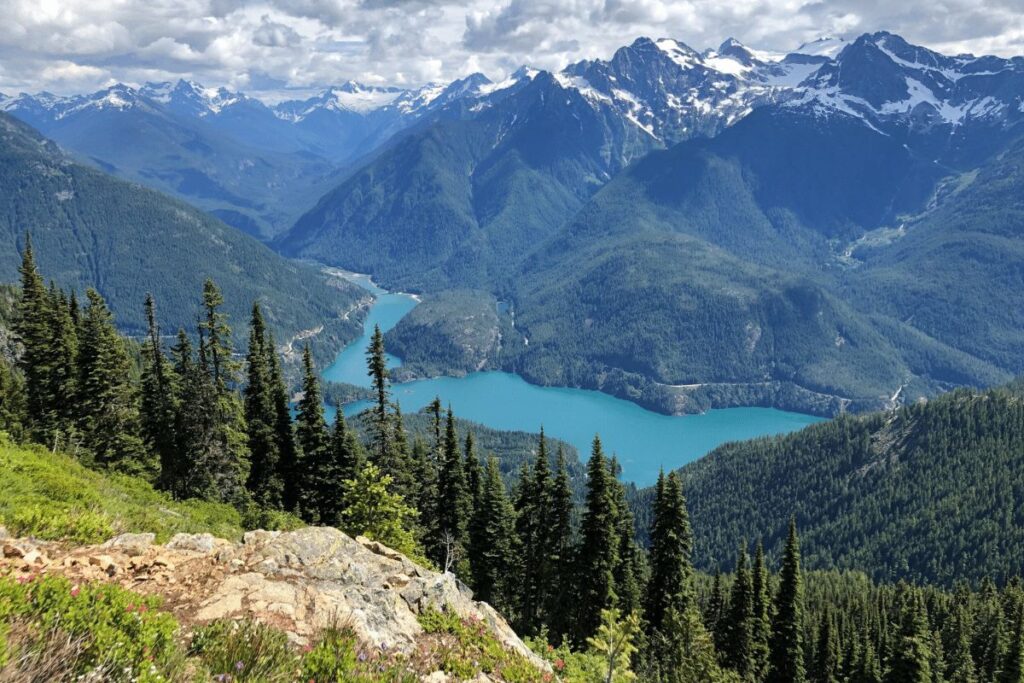
Hikers should be prepared for changing weather conditions and potentially hazardous sections of the trail.
One unique feature of the Sourdough Mountains hike is the stunning wildflower displays during the summer months.
The meadows burst with vibrant colors, including lupines, Indian paintbrushes, and tiger lilies. This vibrant display of wildflowers provides a unique and beautiful experience for hikers and photographers alike.
The Sourdough Mountains are also known for their rich history, with several historic cabins and campsites located along the trail. These cabins offer a glimpse into the past and provide a unique camping experience for hikers looking for a rustic overnight adventure.
The surrounding wilderness area is home to a variety of wildlife, including black bears, mountain goats, and elk, adding to the unique nature of the Sourdough Mountains.
Hikers should be respectful of wildlife and follow Leave No Trace principles to ensure the preservation of the natural environment.
Overall, the Sourdough Mountains offer a unique and beautiful hiking experience, with stunning wildflower displays, historic cabins, and diverse landscapes.
It is an excellent choice for hikers looking for a moderate but rewarding adventure and a chance to connect with the natural beauty of the Olympic Peninsula.
Sauk Mountain
Sauk Mountain is a hidden gem located in the North Cascades, approximately 2 hours north of Seattle. Standing at an elevation of 5,200 feet, this mountain offers stunning views of the surrounding peaks, valleys, and the Skagit River below.
The hike to Sauk Mountain is considered moderate, with a total distance of approximately 2.5 miles round-trip. The trailhead starts at the Sauk Mountain Trailhead and follows the trail through dense forests, over rushing streams, and through alpine meadows.
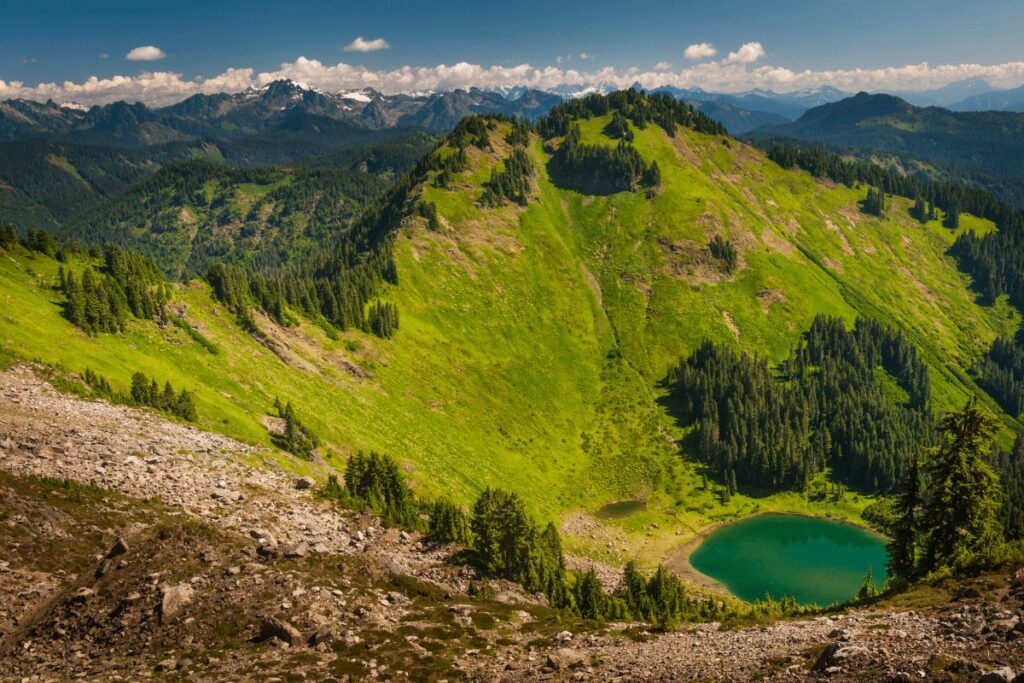
Hikers should be prepared for changing weather conditions, steep switchbacks, and potentially hazardous sections of the trail.
One unique feature of the Sauk Mountain hike is the breathtaking views of the Skagit River Valley and the surrounding peaks, including the Mount Baker and Glacier Peak Wilderness areas. These panoramic views provide a unique and awe-inspiring experience for hikers and photographers alike.
Another unique feature of the Sauk Mountain hike is the variety of alpine wildflowers that bloom along the trail during the summer months.
The meadows burst with vibrant colors, including lupines, Indian paintbrushes, and avalanche lilies. This vibrant display of wildflowers provides a unique and beautiful experience for hikers.
The surrounding wilderness area is home to a variety of wildlife, including black bears, mountain goats, and deer, adding to the unique nature of the Sauk Mountain hike.
Hikers should be respectful of wildlife and follow Leave No Trace principles to ensure the preservation of the natural environment.
Sauk Mountain is also a popular destination for stargazing and astrophotography. The lack of light pollution and high elevation provide optimal viewing conditions for the night sky.
Sauk Mountain offers a unique and beautiful hiking experience, with stunning panoramic views, vibrant wildflowers, and diverse landscapes.
It is an excellent choice for hikers looking for a moderate but rewarding adventure and a chance to connect with the natural beauty of the North Cascades.
Round Mountain
Round Mountain is located in the Cascade Range of Washington State, approximately 2 hours east of Seattle. Standing at an elevation of 5,708 feet, this mountain offers stunning panoramic views of the surrounding peaks and valleys, including the nearby Stuart Range and Wenatchee Mountains.
The hike to Round Mountain is considered moderate to difficult, with a total distance of approximately 6.2 miles round-trip.
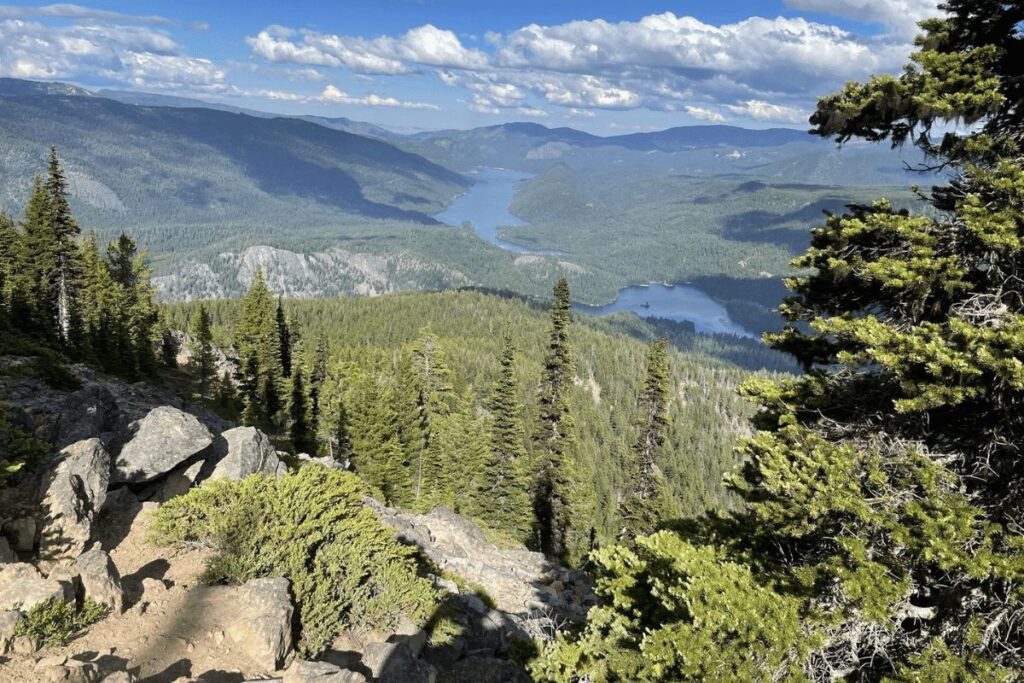
The trailhead starts at the Round Mountain Trailhead and follows a steep and challenging trail through dense forests, over rushing streams, and along rocky ridges.
Hikers should be prepared for changing weather conditions, steep switchbacks, and potentially hazardous sections of the trail.
One unique feature of the Round Mountain hike is the variety of landscapes encountered along the way. The trail takes hikers through dense forests, alpine meadows, and rocky ridges, providing a diverse and stunning hiking experience.
The panoramic views from the summit are particularly breathtaking, with expansive vistas of the surrounding peaks and valleys.
Another unique feature of the Round Mountain hike is the opportunity to encounter a variety of wildlife, including black bears, deer, and mountain goats.
The surrounding wilderness area is home to a variety of wildlife, adding to the unique nature of the Round Mountain hike. Hikers should be respectful of wildlife and follow Leave No Trace principles to ensure the preservation of the natural environment.
One interesting site along the trail is the Round Mountain Lookout, a historic fire lookout that was built in the early 1900s to spot forest fires. The lookout has been preserved and restored, providing a glimpse into the region’s history and serving as a unique destination for hikers.
Round Mountain offers a unique and challenging hiking experience, with stunning panoramic views, diverse landscapes, and unique historical and natural features.
It is an excellent choice for experienced hikers looking for a challenging adventure and a chance to connect with the natural beauty of the Cascade Range.
Mt Baker
Mount Baker, also known as Koma Kulshan by the indigenous Lummi people, is a majestic snow-covered peak located in the North Cascades of Washington State. Standing at an elevation of 10,781 feet, Mount Baker is one of the most prominent peaks in the region and is a popular destination for hikers, climbers, and skiers.
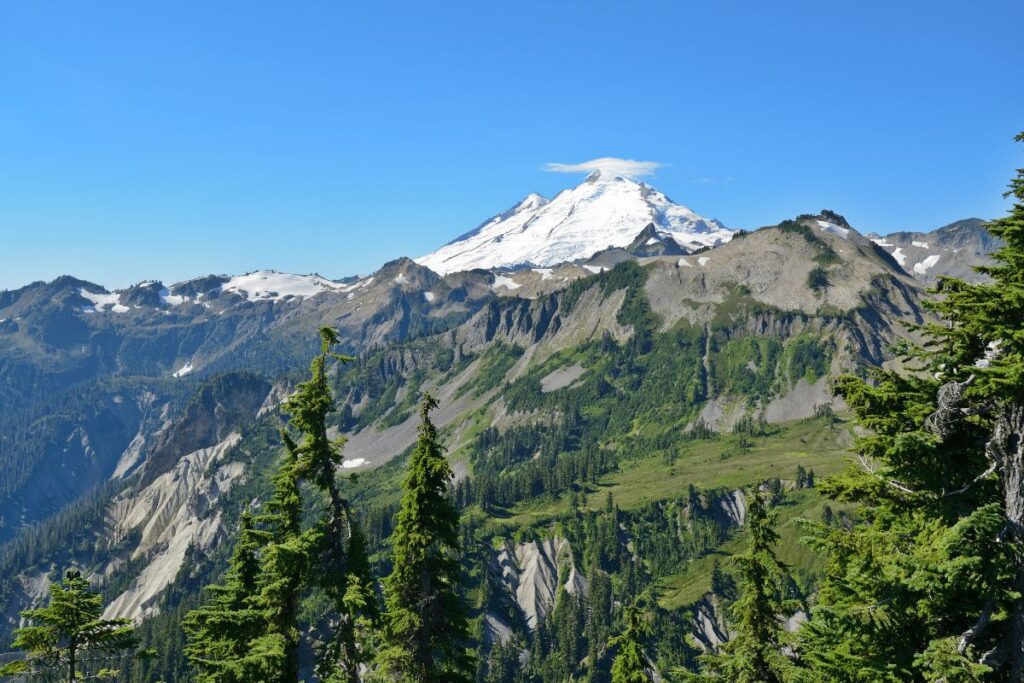
The hike to the summit of Mount Baker is a challenging and technical climb, requiring mountaineering skills and specialized equipment. It typically takes two to three days to complete, and involves glacier travel, steep snow and ice climbing, and exposed ridges.
However, there are also several easier hiking trails in the area that offer stunning views of Mount Baker and the surrounding wilderness.
The most popular trail is the Chain Lakes Trail, a 6.5-mile loop that starts at Artist Point and passes through alpine meadows and around several picturesque lakes, with stunning views of Mount Baker throughout the hike.
One unique feature of Mount Baker is its impressive glaciers, including the Coleman Glacier, the largest glacier on the mountain. The glaciers provide a unique and dramatic backdrop for hikers and climbers, and offer a glimpse into the region’s geological history.
Mount Baker is also home to a variety of wildlife, including mountain goats, black bears, and deer.
Mount Baker is a unique and awe-inspiring destination for hikers and climbers, with its towering peak, impressive glaciers, and stunning views of the surrounding wilderness. Whether you’re a seasoned mountaineer or a casual hiker, there’s something for everyone to enjoy at Mount Baker.
Spire Mountain
Spire Mountain is a lesser-known peak located in the Snoqualmie Pass region of Washington State. Despite its relatively low elevation of 6,550 feet, Spire Mountain offers stunning views of the surrounding Cascade Mountains and is a popular destination for hikers and climbers seeking a challenging adventure.
The hike to the summit of Spire Mountain is a difficult and technical climb, requiring advanced mountaineering skills and equipment. The most popular route is via the West Ridge, which involves steep scrambles and exposed sections along the rocky ridge.
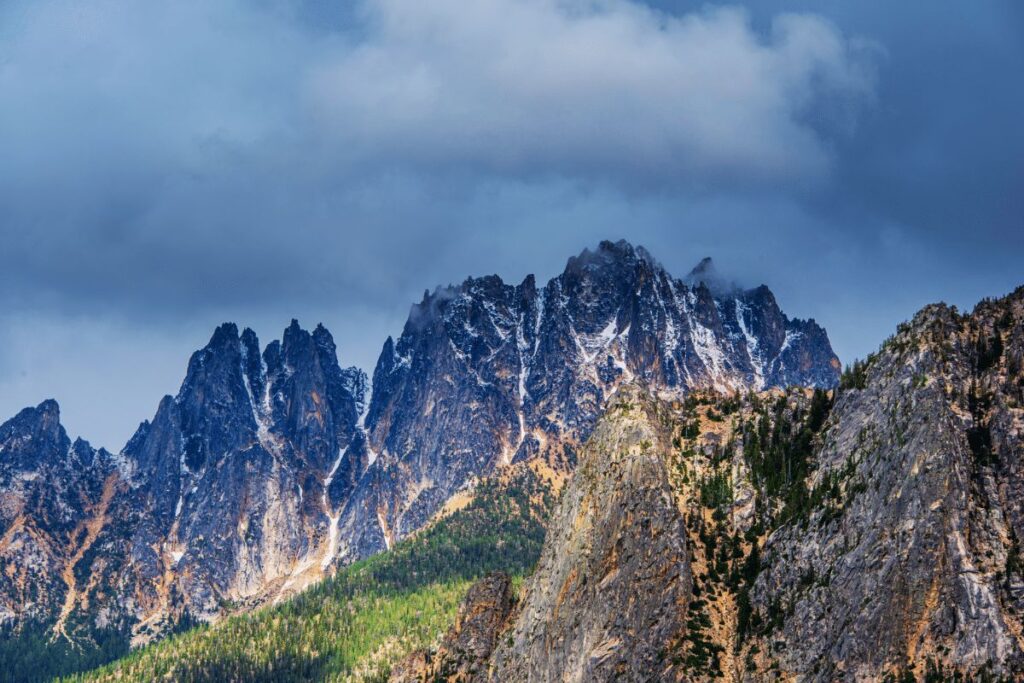
The climb typically takes a full day and involves significant elevation gain and loss, so hikers should be prepared with plenty of water, food, and warm clothing.
One unique feature of Spire Mountain is its rugged and dramatic terrain, which includes towering spires and sharp ridges that offer a thrilling and unforgettable climbing experience.
The peak also offers breathtaking views of the surrounding wilderness, including nearby peaks such as Mount Rainier and Mount Stuart.
In addition to its impressive scenery, Spire Mountain is also home to a variety of wildlife, including mountain goats, black bears, and cougars.
Spire Mountain is a challenging and rewarding destination for experienced hikers and climbers seeking a unique and adventurous experience in the Cascades.
With its rugged terrain and stunning views, Spire Mountain is a must-visit for anyone looking to explore the beauty and diversity of the Pacific Northwest wilderness.
Mt. Higgins
Mt. Higgins is a prominent peak located in the western Cascade Mountains of Washington State, about 80 miles north of Seattle. Rising to an elevation of 5,238 feet, this mountain offers stunning views of the surrounding landscape, making it a popular destination for hikers, backpackers, and nature enthusiasts.
The hike to the summit of Mt. Higgins is a moderate to strenuous trek, with a round-trip distance of approximately 7 miles and an elevation gain of 2,500 feet.
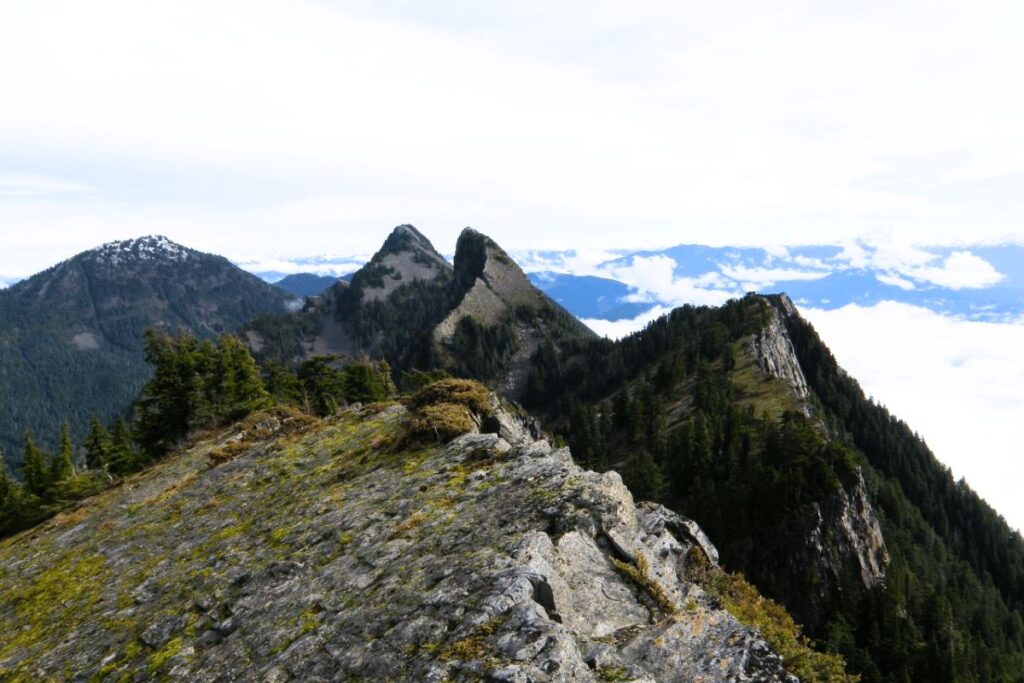
The trail is well-maintained and clearly marked, with a gradual ascent through dense forests and rocky ridges leading to panoramic vistas at the summit.
One unique feature of Mt. Higgins is its proximity to the nearby Pilchuck River, which offers opportunities for fishing, swimming, and other water-based activities.
The mountain is also home to a variety of wildlife, including black bears, cougars, and bald eagles, providing ample opportunities for wildlife viewing and photography.
Another interesting aspect of Mt. Higgins is its rich history, with evidence of human activity dating back thousands of years. The area was once inhabited by the Sauk-Suiattle Indian tribe, who used the mountain for hunting, gathering, and spiritual ceremonies.
In more recent times, the mountain was a site for mining and logging operations, and remnants of these activities can still be seen today.
Mt. Higgins is a beautiful and rewarding destination for those looking to experience the natural beauty and rich history of the Pacific Northwest. With its stunning views, diverse wildlife, and fascinating history, Mt. Higgins is a must-visit for anyone seeking an unforgettable adventure in the Cascade Mountains.
Mt Rainier
Mt. Rainier is a massive stratovolcano located in the Cascade Range of Washington State. At an elevation of 14,411 feet, it is the highest peak in the Cascade Range and the most glaciated peak in the contiguous United States. This iconic mountain is located about 60 miles southeast of Seattle and is visible from many parts of the region.
The climb to the summit of Mt. Rainier is a serious mountaineering endeavor, requiring extensive experience and technical skills.
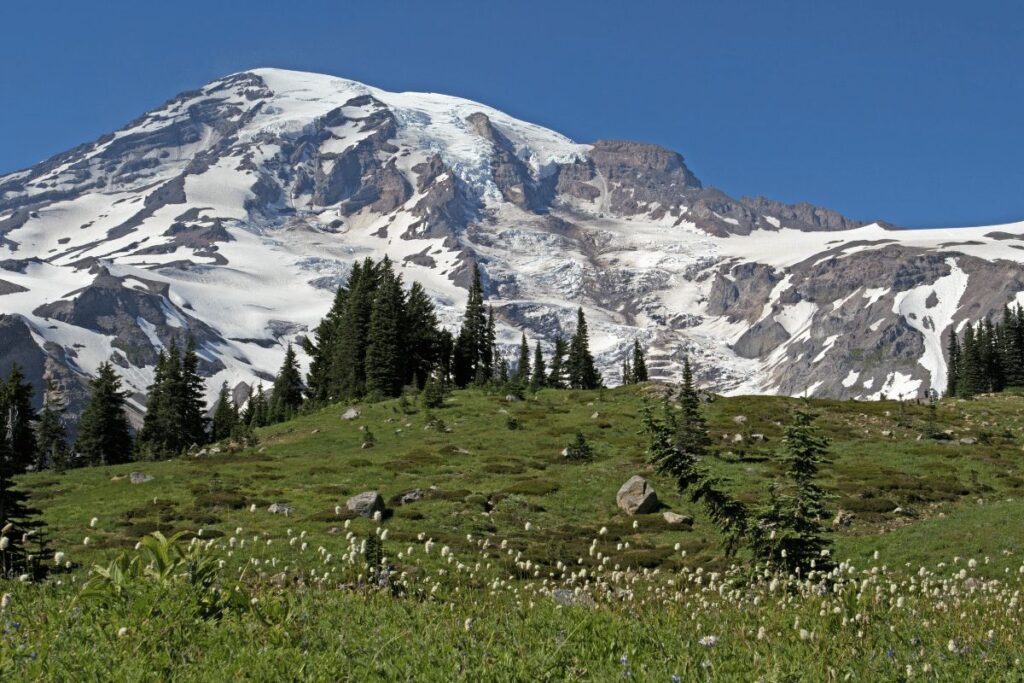
However, there are many opportunities for hikers and nature enthusiasts to explore the stunning landscape surrounding the mountain. The area is home to an abundance of wildlife, including elk, black bears, and mountain goats.
One of the most popular destinations in the Mt. Rainier area is Paradise, located on the south side of the mountain. This area is known for its wildflower meadows, which burst into bloom in late spring and early summer.
The Paradise area also offers a number of hiking trails, ranging from easy strolls to challenging backcountry routes.
Another popular destination in the Mt. Rainier area is Sunrise, located on the eastern side of the mountain. This area is known for its stunning views of the surrounding landscape and its network of hiking trails. The Sunrise area is also home to the highest point on the Mt. Rainier road system, at an elevation of 6,400 feet.
For those looking for a more immersive experience, there are many backcountry camping options available in the Mt. Rainier area. Permits are required for all overnight stays in the backcountry, and hikers should be prepared for changing weather conditions and rugged terrain.
Also Read: 13 North Cascades National Park Trails That Will Make You Surrender To Nature!
Mt. Rainier is a must-visit destination for anyone seeking to experience the natural beauty and majesty of the Pacific Northwest. With its stunning views, abundant wildlife, and endless opportunities for exploration, Mt. Rainier is a true gem of the Cascade Range.
Mount St. Helens
Mount St. Helens is a volcano located in the Cascade Range of Washington State, about 50 miles northeast of Portland, Oregon. The mountain is notorious for its catastrophic eruption on May 18, 1980, which was one of the deadliest and most destructive volcanic events in U.S. history. The eruption resulted in the loss of 57 lives, destroyed over 200 homes, and caused extensive damage to the surrounding landscape.
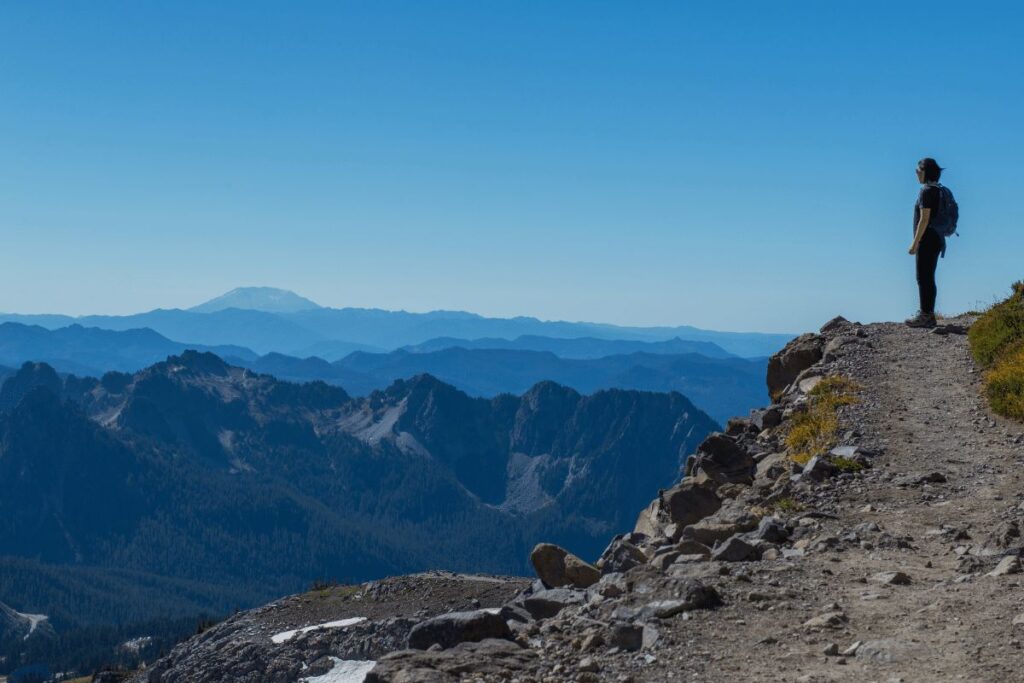
Today, visitors to Mount St. Helens can witness the power of this volcanic giant up close. The mountain is part of the Mount St. Helens National Volcanic Monument, which was established in 1982 to protect and preserve the area affected by the eruption. The monument includes a visitors center, several hiking trails, and a variety of educational exhibits and programs.
One of the most popular hiking trails in the monument is the Ape Cave Trail, which takes visitors through a lava tube formed by the eruption. The trail is a unique opportunity to explore the aftermath of the eruption and to witness the power and beauty of nature at work.
Another popular destination in the monument is the Johnston Ridge Observatory, located on the north side of the mountain. The observatory offers stunning views of the crater and the surrounding landscape, as well as a variety of exhibits and programs exploring the history and science of the eruption.
For those seeking a more immersive experience, there are also opportunities for backcountry camping and hiking in the monument. Permits are required for all overnight stays in the backcountry, and hikers should be prepared for rugged terrain and changing weather conditions.
Mount St. Helens is a fascinating and awe-inspiring destination, offering visitors a chance to witness the power and beauty of nature in action. Whether you’re exploring the Ape Cave Trail, taking in the stunning views from the Johnston Ridge Observatory, or venturing into the backcountry, a visit to Mount St. Helens is sure to be an unforgettable experience.
Granite Mountain
Granite Mountain is a popular hiking destination located in the Snoqualmie Pass region of Washington State. The mountain is part of the Alpine Lakes Wilderness, a pristine wilderness area known for its rugged peaks, alpine lakes, and stunning views.
The trail to Granite Mountain is a challenging but rewarding hike, offering panoramic views of the surrounding mountains and valleys. The trail is 8.6 miles round trip with an elevation gain of 3,800 feet, making it a great option for experienced hikers looking for a challenge.
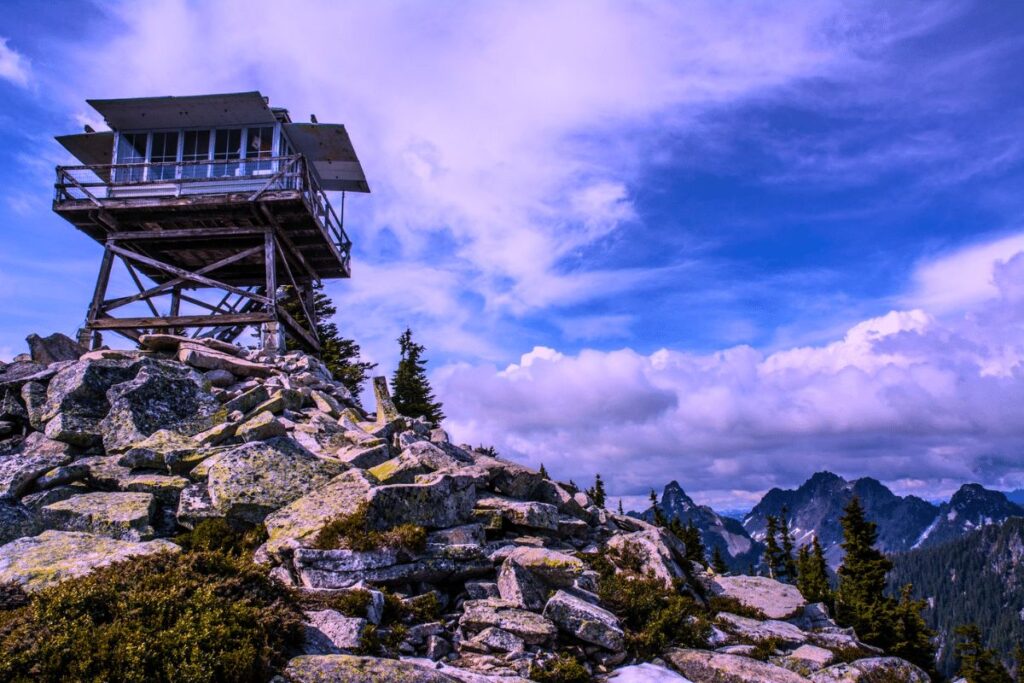
Along the way, hikers will pass through a variety of terrain, from dense forests to rocky ridgelines. One unique feature of the trail is the granite boulders and outcroppings that dot the landscape, providing a glimpse into the geologic history of the area.
At the summit of Granite Mountain, hikers will be rewarded with breathtaking views in every direction. On a clear day, hikers can see as far as Mount Rainier to the south and Mount Baker to the north. The summit also offers a unique perspective on the nearby ski slopes of the Snoqualmie Pass area.
In addition to its stunning natural beauty, Granite Mountain also holds a special place in the hearts of many locals as a memorial to six hikers who lost their lives in a tragic accident in 1995. A plaque at the summit honors their memory and serves as a reminder of the importance of safety and preparation when venturing into the wilderness.
Granite Mountain is a must-visit destination for any avid hiker or nature enthusiast in the Pacific Northwest. Its rugged beauty and breathtaking views make it a truly unforgettable experience.
Tiger Mountain
Tiger Mountain is a beloved hiking destination located just a short drive from Seattle. Despite its proximity to the city, Tiger Mountain feels like a world away, offering a peaceful escape into the heart of the Pacific Northwest wilderness.
The mountain is home to an extensive network of trails that wind through dense forests, rocky outcroppings, and open meadows. One of the most popular hikes on Tiger Mountain is the Tiger Mountain Trail, a 15.2-mile loop that offers stunning views of the surrounding mountains and valleys.

But hiking isn’t the only way to enjoy Tiger Mountain. The mountain is also home to a variety of other outdoor activities, including mountain biking, horseback riding, and even paragliding.
For thrill-seekers, Tiger Mountain’s steep slopes and rocky terrain provide a challenging and rewarding playground.
One of the unique features of Tiger Mountain is the presence of a decommissioned Nike missile site, which served as a Cold War-era defense system. Today, the site is open to visitors and serves as a fascinating glimpse into a bygone era of American history.
Another unique feature of Tiger Mountain is the abundance of wildlife that calls it home. Lucky hikers may spot deer, elk, black bears, and even cougars along the trails. Bird watchers will also be delighted by the diverse range of species that can be seen in the forests and meadows.
Whether you’re an experienced hiker or just looking for a quick escape from the city, Tiger Mountain is a must-visit destination for anyone in the Seattle area.
With its stunning natural beauty, diverse range of outdoor activities, and fascinating history, there’s something for everyone on this majestic mountain.
Gothic Peak
Gothic Peak is a stunning mountain located in the North Cascades, just a few hours’ drive from Seattle. This iconic peak is known for its distinctive jagged ridge, which offers a challenging and rewarding climb for experienced hikers and mountaineers.
The most popular route to the summit of Gothic Peak is via the Gothic Basin trail, which begins at the Barlow Pass Trailhead.
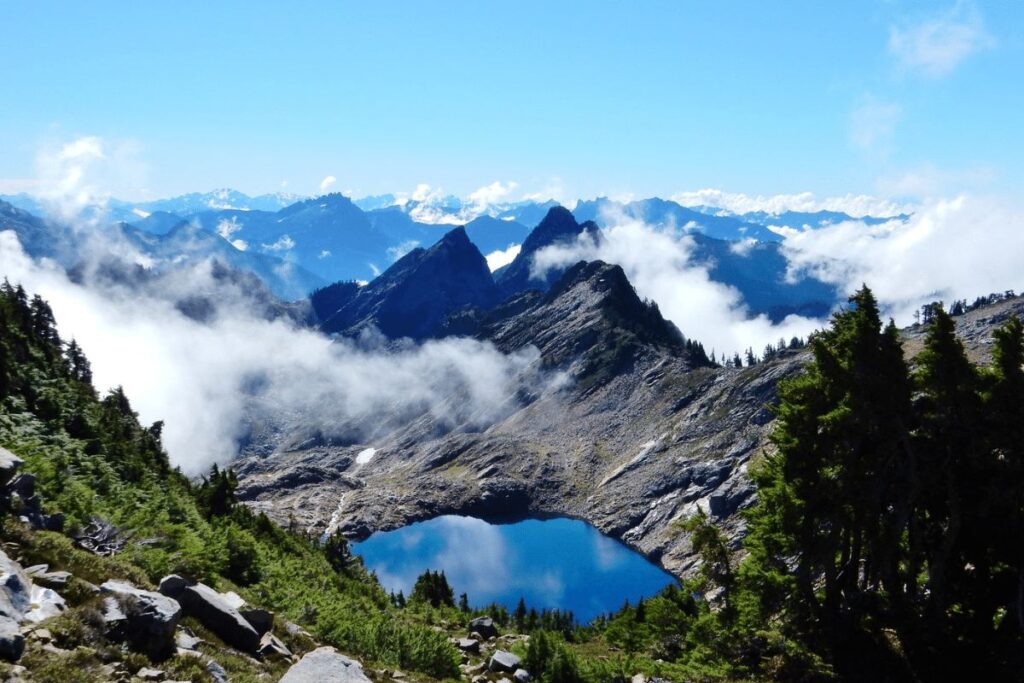
The trail winds through dense forests and alpine meadows before ascending to Gothic Basin, a beautiful alpine lake surrounded by towering peaks. From there, hikers can scramble up the rocky ridge to reach the summit of Gothic Peak.
The climb to the top of Gothic Peak is not for the faint of heart. The route is steep and exposed, requiring a high level of fitness and mountaineering skills.
However, for those who are up to the challenge, the views from the summit are truly breathtaking. From the top of Gothic Peak, hikers can take in panoramic views of the surrounding mountains, valleys, and glaciers.
One of the unique features of Gothic Peak is the opportunity to explore the surrounding Gothic Basin.
This beautiful alpine valley is home to a diverse range of wildlife, including mountain goats, marmots, and pikas. In the summer months, the basin is also filled with wildflowers, making it a popular destination for photographers and nature enthusiasts.
Gothic Peak is a challenging but rewarding climb that offers stunning views and the opportunity to explore the beauty of the North Cascades. While it may not be the easiest hike, the sense of accomplishment and awe-inspiring scenery make it well worth the effort for those up for the challenge.
Glacier Peak
Glacier Peak is a massive stratovolcano located in the heart of the North Cascades National Park. With an elevation of 10,541 feet (3,213 meters), it is the fourth-highest peak in Washington state and is renowned for its rugged beauty and challenging terrain.
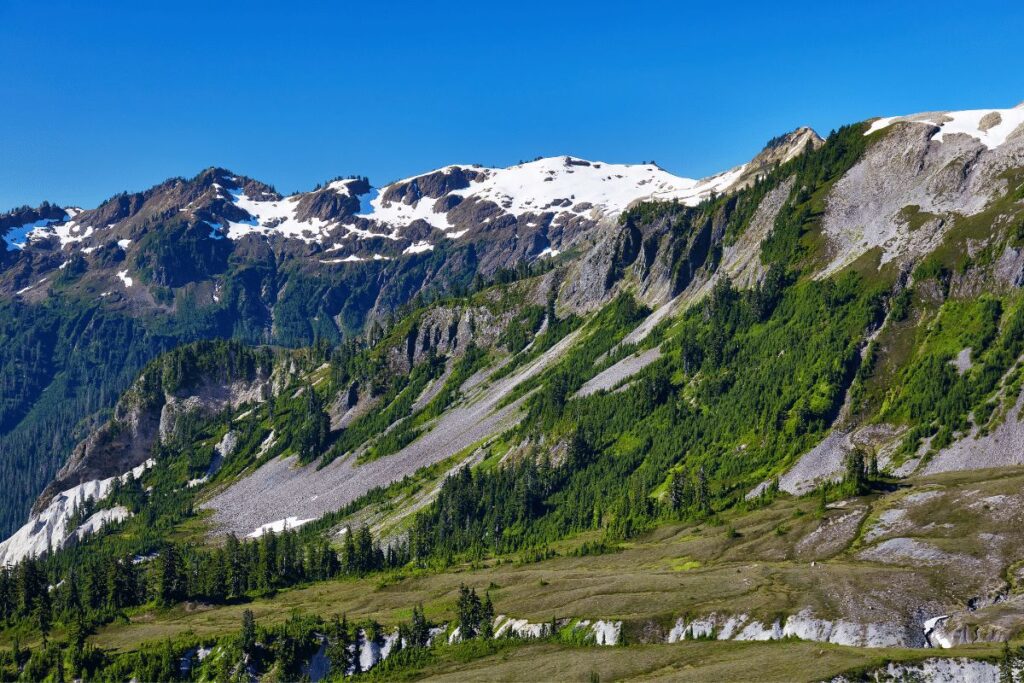
The most popular approach to Glacier Peak is via the Glacier Peak Wilderness Area, where hikers can access the mountain via the North Fork Sauk River trail.
From there, the route to the summit of Glacier Peak requires a combination of hiking and mountaineering skills, including traversing steep and exposed snowfields and navigating through glacial moraines.
One of the unique aspects of climbing Glacier Peak is the opportunity to explore the pristine wilderness surrounding the mountain.
The Glacier Peak Wilderness Area is home to some of the most remote and untouched forests, meadows, and lakes in the state, offering hikers a truly immersive wilderness experience.
Along the way, hikers can spot a variety of wildlife, including black bears, mountain goats, and elk.
At the summit of Glacier Peak, hikers are rewarded with breathtaking views of the surrounding North Cascades, including the Picket Range, Mount Baker, and Mount Rainier. On a clear day, hikers can even see as far as the Olympic Mountains and the San Juan Islands.
While the climb to the summit of Glacier Peak is not for the inexperienced, it offers a challenging and rewarding adventure for experienced hikers and mountaineers. With its rugged beauty, pristine wilderness, and awe-inspiring views, Glacier Peak is a must-visit for anyone seeking an unforgettable mountain experience in the Pacific Northwest.
Wildlife in the mountains around Seattle
The mountains around Seattle are home to a diverse array of wildlife, making them not just scenic but also fascinating for nature lovers. From black bears and mountain goats to elk and cougars, the region’s mountains are teeming with life.
One of the most iconic creatures found in the mountains around Seattle is the black bear. These animals are known for their black fur and are typically found in wooded areas.
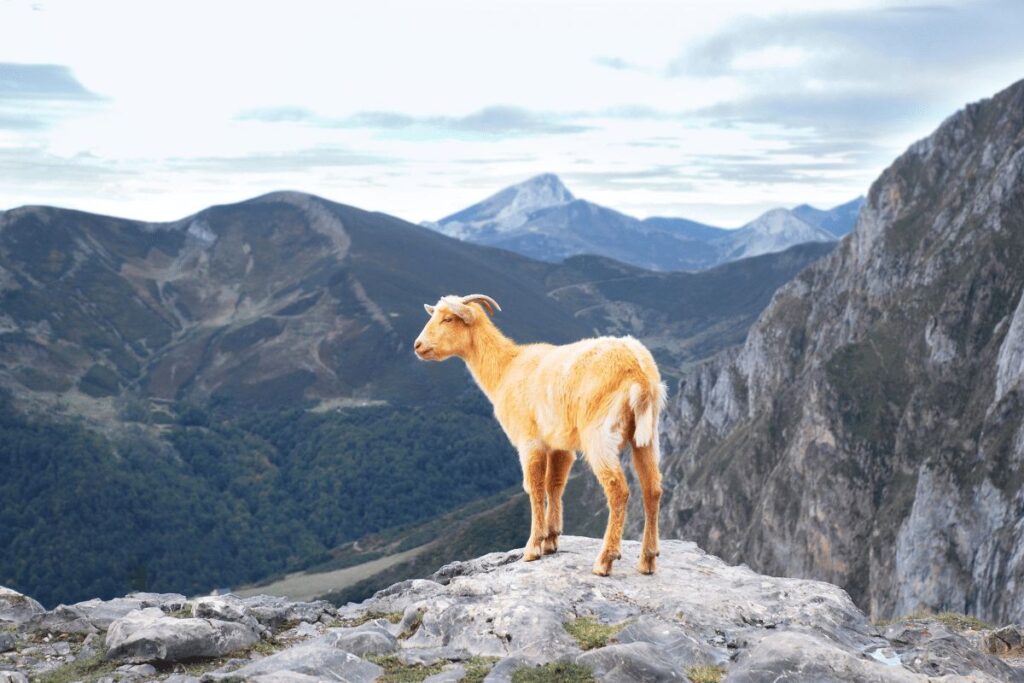
While they are generally not aggressive towards humans, hikers are advised to take precautions such as carrying bear spray and making noise while hiking to avoid surprising them.
Mountain goats are another common sight in the region’s mountains. These nimble animals are known for their white coats and impressive ability to scale steep cliffs. Hikers may spot them grazing on the slopes or rocks near the trails.
Elk are also found in the mountains around Seattle, particularly in the higher elevations. These majestic animals are known for their impressive antlers and can be seen grazing in meadows and along streams.
Other notable wildlife in the region’s mountains include cougars, coyotes, and marmots. While cougars are rarely seen, hikers should be aware of their presence and take precautions such as traveling in groups and carrying bear spray.
Coyotes are more commonly seen and can often be heard howling in the evenings. Marmots, meanwhile, are known for their distinctive high-pitched chirping and can often be seen sunning themselves on rocks.
It’s important for hikers to remember that they are visiting the animals’ natural habitats and to respect their space. This means avoiding feeding them or getting too close, as this can disrupt their natural behaviors and potentially put both the hiker and the animal at risk. With proper precautions and a respectful attitude, hikers can enjoy the fascinating wildlife of the mountains around Seattle.
Conclusion
The mountains around Seattle offer a wealth of opportunities for hikers and nature lovers alike. Whether you’re an experienced mountaineer looking for a challenging ascent or a casual hiker seeking a scenic stroll, the region’s peaks have something to offer.
From the iconic Mt. Rainier to lesser-known gems like Bessemer Mountain and Sourdough Mountains, there are trails to suit all levels of experience and interest.
As we’ve seen, the mountains around Seattle are also home to a fascinating array of wildlife.
From majestic elk to nimble mountain goats and elusive cougars, the animals of the region’s mountains add an extra layer of excitement to any hiking adventure. It’s important for hikers to respect the animals’ space and take proper precautions to ensure their safety.
Whether you’re seeking the thrill of a summit or the serenity of a quiet forest trail, the mountains around Seattle have it all. With a little preparation and a sense of adventure, you can explore the beauty and wonder of this unique region and the incredible wildlife that calls it home.

